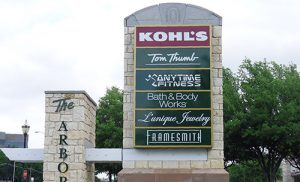 Have you ever driven by a retail center and not noticed the businesses that are in the center? Maybe you drive by it every day. But if asked, you couldn’t name a single business there. The location might be ideal, but nothing caught your eye; and that’s a big problem.
Have you ever driven by a retail center and not noticed the businesses that are in the center? Maybe you drive by it every day. But if asked, you couldn’t name a single business there. The location might be ideal, but nothing caught your eye; and that’s a big problem.
Signage is the advertising for your property and greatly affects its curb appeal. It’s the first impression a tenant makes on a potential customer and is therefore a key factor in a retail building’s and its tenants’ success.
Most of the time drivers are, well, driving. The time a business has to make an impression on a prospect is very small. Split-second decisions are decided by the quality of the signage and can affect the decision to visit a business or not. Yet so often, landlords allow a building’s signage to fall into disrepair, look haphazard and incongruent, become outdated aesthetically, or inaccurately identify the current tenants.
Signage is almost exclusively a landlord’s choice and not the tenants’ decision. Some landlords are hesitant to spend money on signage, because normally signage is not a pass-through expense. However, not maintaining the signage quality can severely impact a center’s image. Running a small business is difficult and margins are often razor-thin, so the additional traffic and revenue that can be generated by quality signage may make or break a business. And as any experienced retail landlord knows, the benefits of thriving tenants are profound: higher rents, lower turnover, fewer tenant complaints – in short, greater NOI and building value.
The theory and practice of signage design is a field of research unto itself, and includes branding, color theory, human psychology and messaging. For our purposes, we will focus on exterior monument signage, since that’s the initial impression and the calling card of a tenant and a center.
Visibility
Signs are only helpful if they’re visible. Acceptable size, lighting and design parameters are often locally dictated by the city, the neighborhood or an association, so it’s imperative to consult their requirements or guidelines before making any major sign changes or additions. When working within those parameters, it’s important to make the following considerations:
Line of Sight: Analyze the property from every direction to ensure your sign is visible. If your center is dependent on vehicle traffic, get in your car and approach the property from every direction. Similarly, if your site relies on foot traffic, walk around to help identify the best siting for your proposed signage.
Size: You want the signs to be as large as is legally allowable without being obnoxious. A sign company can recommend sizes based on local sign codes.
Readability/Legibility: It’s important that the text and colors make the signs easy to decipher and comprehend. Oftentimes, in an attempt to add artistic flair, signs end up as an incomprehensible jumble. Follow the KISS rule – Keep It Simple Signage. Too much information usually means too many characters and fonts that are too small to read.
Night Visibility: We have all seen signage that does not work or only partially works at night. Check your signage at night to make sure it’s visible, and make any lighting repairs or replacements immediately.
Design
Monument signs should be attractive and eye-catching, as well as durable. All sign companies have staff who can help you with the design process – from size, color and font selection, to local regulations and material choice. Use these professionals to design the perfect sign for your commercial site. This is no time for DIY. Don’t settle for the cheapest sign you can buy; not only will potential shoppers notice, so will potential lessees!
Consistency
All of the signs on a property should be thematically consistent. You should be thinking like a marketing professional; this is your building’s brand. Consistent signage reflects a level of thought, care, and pride that will be noticed. As the landlord, you are in control of the design aesthetic of the tenants’ individual signs. Most leases include clauses that state landlord approval is required for any signage. If you are leasing space with a monument sign on the property, make sure your lease provides specific information about the sign’s size, position, lighting, and any other design requirements.
Flexibility
Trends change and tenants change. If you purchase a sign or construct a monument, consider your future signage needs. Individual tenants will change over time, and the number of tenants may vary if spaces are combined or divided. If your monument sign advertises the individual tenants, make sure that it’s designed to easily accommodate those changes.
Accuracy
Nothing reflects more poorly on a building than old signs left hanging that advertise defunct tenants. If a customer wastes time looking for a business that has moved out, they may be so frustrated they don’t bother looking at the center ever again. When a tenant moves out, remove their business signage immediately, and possibly replace it with a “for lease” sign.
Way-Finding
It’s also critical that customers are able to quickly and easily reach their destination within your commercial center. If the center has numerous businesses or multiple street turns, make sure that you provide “way-finding” signage that helps drivers navigate their way to the center effortlessly and park in the appropriate place near their desired business. You want the overall arrival experience to be as pain-free for customers as possible.
Income Opportunity
You may be able to capture income from prime advertising space, whether it’s on the entrance monument(s) or the most visible corners of the buildings. This is additional income is often overlooked; find out what is allowable by the controlling authorities and offer the space as an additional rentable item to the tenants.
Monument signage is key to a retail center’s success and desirability. As the landlord, you are the key decision-maker regarding a most critical aspect of the building’s success. The end goal of any retail center is to maximize customer traffic. A well thought-out, purposeful monument signage plan will be noticed by existing tenants, prospective lessees and customers.
Mark W. Kennedy is the President of Wheelhouse Commercial in Denver, Colorado. For more information about how Wheelhouse Commercial can help manage your properties, please call 303.518.7406 or email info@wheelhousecommercial.com.
is the President of Wheelhouse Commercial in Denver, Colorado. For more information about how Wheelhouse Commercial can help manage your properties, please call 303.518.7406 or email info@wheelhousecommercial.com.

